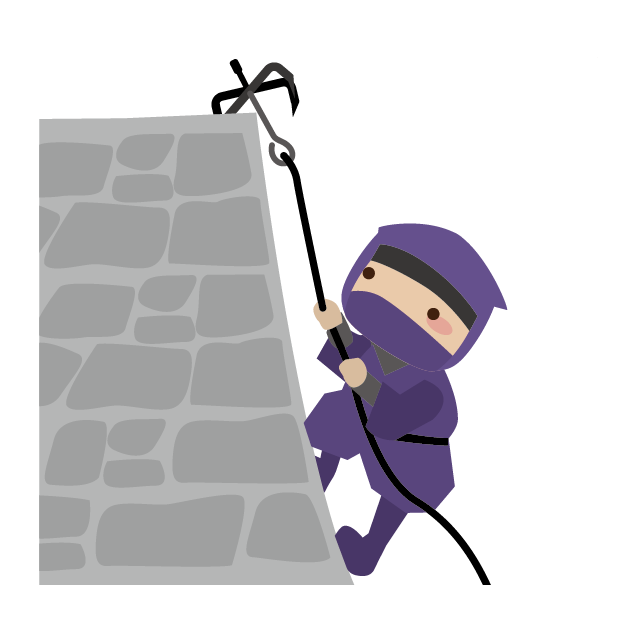鉤縄(かぎなわ)――忍びの道を切り拓く、静かなる道具
忍者といえば、黒装束に手裏剣、そして屋根をひょいと飛び越える姿を思い浮かべる者が多かろう。
だが、その俊敏な動きの裏には、己の身体能力だけでなく、巧妙な道具の数々が支えておるのじゃ。
本日紹介するのは、その中でもとりわけ実用性に富んだ道具——
それが 「鉤縄(かぎなわ)」 じゃ!
鉤縄とは何か?
忍者が用いた道具の中でも、派手さはないが極めて実用性が高いのがこの 鉤縄(かぎなわ)。
鉤縄とは、鉤(かぎ)状の鉄製フックと、丈夫な縄を組み合わせた登攀(とうはん)道具。
敵の城壁や屋根、塀などに引っかけて登ったり降りたりするために用いられた、まさに忍びの命綱じゃな。
その実用性と忍者らしさゆえに、有名な忍術書『正忍記(しょうにんき)』にも「忍び六具(しのびろくぐ)」の一つとして記されておるのじゃ。
鉤縄の用途――登る、掴む、仕掛ける
鉤縄は使い方次第で、さまざまな任務に対応できる柔軟な道具じゃ。
- 塀や屋根へ登るための足がかりに
- 屋根や高所から静かに降りるときの補助に
- 高所にある道具や縄を引き寄せるために
- 隠しておいた装備や火薬を遠方から回収するために
- 山道などで足場の確保に使う移動補助具として
投げて引っかける、結んで吊るす、隠して備える……
どの場面でも、忍びの柔軟さに応じた使い方ができたのじゃ。
鉤縄の構造に宿る工夫
鉤縄の鉤は、三本または四本の鉤爪(かぎづめ)から成っておる。
これにより、どの角度からでも引っかかりやすくなり、成功率が高まる仕組みじゃ。
現代でいえば「グラップリングフック」に近い道具とも言えるのう。
縄には麻や絹などの素材が用いられ、強度としなやかさを両立。
また、夜の潜入時に目立たぬよう、墨で黒く染められていたとも伝わっておる。
まさに、道具にも「気配を消す」という忍びの精神が宿っていたのじゃな。
戦わずして潜入するための道具
忍者の任務は、「敵と戦う」ことではない。
真に大切なのは、「生きて情報を持ち帰ること」。
騒がず、傷つかず、無事に帰還する——
それこそが忍者にとっての最高の成果じゃ。
ゆえに鉤縄は、「目立たずに目的地へ到達し、無事に去る」ための道具として、極めて重要な役割を果たしておったのじゃ。
音を立てぬよう慎重に、壁を這い、屋根を越え、時には川を渡る……
まさに、静かなる忍びの相棒じゃった。
まとめ:鉤縄は、忍びの道を支えた知恵の結晶
鉤縄は、ただのロープにあらず。
登る・降りる・引き寄せる——あらゆる場面で活用できる、実に忍者らしい“多機能道具”であったのじゃ。
戦わずして勝ち、騒がずして達する。
それを可能にするのが、こうした鉤縄のような実用性に富んだ道具なのである。
そしてこの鉤縄、先にも申した通り、『正忍記』に記された「忍び六具(しのびろくぐ)」のひとつでもある。
他の五つの道具もまた、忍びの知恵と工夫が詰まったものばかり。
……さて、その残る五具とは一体何か?
それはまた、次の機会に語るとしようかの――
【以下英語版】【English version below】
Kaginawa – The Silent Tool That Opened the Way of the Ninja
When one thinks of a ninja, many imagine a figure in black, hurling shuriken and leaping from rooftop to rooftop.
But behind that agile movement lies not only physical prowess but also the clever use of many specialized tools.
Today, we shine a light on one of the most practical tools in the ninja’s arsenal:
The Kaginawa (Grappling Hook).
What is a Kaginawa?
Among the many tools used by ninjas, few are as practical—yet understated—as the Kaginawa.
The Kaginawa consists of an iron hook shaped like a claw, combined with a sturdy rope.
It was used to climb walls, roofs, and fences, or to descend from high places—a true lifeline for a shinobi.
Because of its practicality and deep association with stealth, the Kaginawa was listed in the famous ninja manual Shōninki as one of the essential “Shinobi Rokugu” (Six Tools of the Ninja).
Uses of the Kaginawa – Climb, Hook, Deploy
The Kaginawa was a flexible tool that could adapt to many missions depending on the situation.
- Used to climb over walls and rooftops
- Helpful for descending quietly from high places
- Retrieve ropes or tools placed at heights
- Recover hidden supplies or explosives from a distance
- Assist in difficult terrain as a climbing aid
Throw, hook, tie, and conceal—it matched the ninja’s creativity and flexibility in every situation.
The Clever Construction of the Kaginawa
A typical Kaginawa had three or four iron claws, designed to catch from any angle, improving the chance of a successful hook.
The rope was made from materials like hemp or silk, balancing strength and flexibility.
It was also said to be dyed black with ink, so it wouldn’t stand out during night operations.
Even in the tools they carried, ninjas maintained their principle of invisibility and discretion.
A Tool for Infiltration, Not Combat
The ninja’s mission was not to fight, but to gather information and return safely.
To succeed meant to escape undetected, without bloodshed or confrontation.
That made the Kaginawa an essential tool—allowing a ninja to reach a destination silently and vanish without a trace.
Crawling along walls, slipping over rooftops, and even crossing rivers without a sound…
The Kaginawa was truly a quiet companion in the shadows.
Conclusion: The Kaginawa, a Masterpiece of Ninja Ingenuity
The Kaginawa was far more than just a rope.
It was a multi-purpose tool that enabled climbing, descending, retrieving, and more—an embodiment of the ninja’s resourcefulness.
To win without fighting. To reach without noise.
Such ideals were made possible through practical tools like the Kaginawa.
As mentioned earlier, the Kaginawa was one of the Shinobi Rokugu (Six Tools of the Ninja) listed in the Shōninki.
The remaining five are also filled with deep wisdom and ingenuity.
…What are these other five tools, you ask?
Well now, that is a tale for another time.



